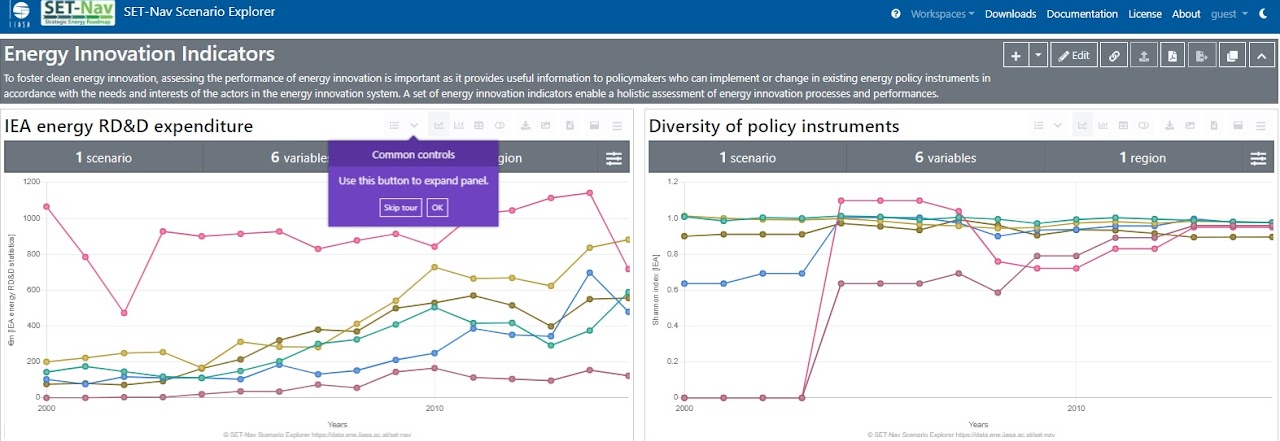- Publications -
Woo, D., & Kim, Y. J. (2025). Data-driven Insights into South Korea's National Utilization of the EV Charging Infrastructure Environmental Research: Infrastructure and Sustainability
Kim, Y. J., & Cho, S.H.(2023). Is the discovery of oil a blessing or curse in the era of climate change? Resources Policy.
Sanni, M., & Kim, Y. J. (2023). How open are African inventors? Open green technologies and patenting activities in Africa. African Journal of Science, Technology, Innovation and Development.
Herman, K., Kim, Y. J, Soheil S., & Xiang J. (2023). A Critical Review of Green Growth Indicators in G7 Economies from 1990 to 2019 Sustainability Science
Kim, Y. J., & Verdolini, E. (2023). International knowledge spillovers in energy technologies. Energy Strategy Reviews, 49, 101151
Hyun, M., Cherp, A., Jewell, J., Kim, Y. J., & Eom, J. (2023). Feasibility trade-offs in decarbonising the power sector with high coal dependence: The case of Korea. Renewable and Sustainable Energy Transition, 100050.
Choi, D., & Kim, Y. J. (2023). Local and global experience curves for lumpy and granular energy technologies. Energy Policy, 174, 113426.
Kim, Y. J., Soh, M., & Cho, S.-H. (2022). Identifying optimal financial budget distributions for the low-carbon energy transition between emerging and developed countries. Applied Energy, 326, 119967.
Kim, Y. J. (2022). The countervailing effects of stocks of knowledge on low-carbon innovation through international collaboration. Energy Policy, 170, 113217.
Kim, Y. J., Cho, S.-H., & Sharma, B. P. (2021). Constructing efficient portfolios of low-carbon technologies. Renewable and Sustainable Energy Reviews, 150, 111515.
Hyun, M., Kim, Y. J., & Eom, J. (2020). Assessing the impact of a demand-resource bidding market on an electricity generation portfolio and the environment. Energy Policy, 147, 111918.
Kim, Y. J., & Wilson, C. (2019). Analysing Energy Innovation Portfolios from a Systemic Perspective. Energy Policy, 134 (2019) 110942.
Kim, Y. J., & Wilson, C. (2019). Analysing Future Change in the EU’s Energy Innovation System. Energy Strategy Reviews, 24C (2019) pp. 279-299.
Kim, Y. J., & Brown, M. A. (2019). The impact of domestic energy-efficiency policies on foreign innovation: the case of lighting technologies. Energy Policy, 128, 539-552.
Kim, Y. J., Husbands Fealing, K., & Klochikhin, E. (2018). Patenting activity in the food safety sector. World Patent Information, 55, 27-36.
Brown, M. A., Baer, P., Cox, M., & Kim, Y. J. (2014). Evaluating the risks of alternative energy policies: a case study of industrial energy efficiency. Energy Efficiency, 7(1), 1-22.
- Reports -
Verdolini E, Reis LA, Drouet L, Tavoni M, Kim YJ, Bonacorsi L, et al. The international dimension of the EU low-carbon transition. 2021.
Karakosta, C., Papapostolou, K., Granado, P. C. del, Egging, R., Welisch, M., Hartner, M., … Johansen, U. (2019). Navigating the roadmap for clean, secure and efficient energy innovation: Final report on SET-Nav policy briefs.
Granado, P. C. del, Welisch, M., Hartner, M., Resch, G., Lumbreras, S., Olmos, L., … Ansari, D. (2019). Summary Report “SET-Nav-Integrative policy recommendations” Decarbonization the EU’s Energy System.
Global Innovation Index 2018 Report published by Cornell University, INSEAD, and the World Intellectual Property Organization: Technology-Specific Analysis of Energy Innovation Systems (with Charlie Wilson)
Kaye Husbands Fealing, Stanley Johnson, John L. King, and Julia Lane, New Pathways to Research Impact: Case of Food Safety, Cambridge University Press. Chap 9: patenting across businesses(with Evgeny Klochikin and Kaye Husbands Fealing)
- Under Review -
The air quality effects of Uber (with Luis Sarmiento)
Leaving Someone Behind: Coal Phase-Out in South Korea
Tradeoffs between the Time and Cost of Electric Vehicle Charging in Korea
Energy Transitions Post–Russia–Ukraine War: Challenges and Policy Implications in Germany and Italy
- Environmental policies and embodied emissions exports and imports (with Elena Verdolini and Laura Bonacorsi)
- In the absence of a global greenhouse gas reduction mechanism, the EU adopted the strongest climate mitigation policy in the world. As a result of this, there are concerns about the challenges faced by EU carbon-intensive and trade-exposed countries and industries as well as regarding the effective contribution of EU climate policies to GHG emission reductions. On the one hand, competitiveness may be harmed due to the unilateral nature of climate mitigation policy and the impact this can have on trade flows and balances. On the other hand, European demand for foreign carbon-intensive good may increase, potentially offsetting any emission reduction efforts. In this initial analysis, we assess whether and how embodied emissions in traded goods have changed over time, particularly in response to the implementation of climate mitigation policies. Our analysis provides insights both at the country level and at the sector level. We find evidence that stringent environmental policies are associated with lower exported emissions and emissions intensity, but mixed evidence on their effects on imported emissions and imported emissions intensity. Overall, we do not find conclusive evidence supporting the pollution haven hypothesis.
- Responsiveness of scientific research systems to covid-19 pandemic: an empirical study at the country-level (with Taehyun Jung)
- COVID-19, spreading rapidly worldwide since January 2020, profoundly affected all aspects of economic and social systems. The science and technology research community played a significant role in developing a scientific solution to this calamity. While the extant literature discusses how science and innovation systems can contribute to the resilient recovery of socio-ecological and regional systems, it overlooked how resilient scientific research systems are and what makes them different. Using early academic responses to the COVID-19 pandemic as an empirical setup, we examine the factors affecting the heterogeneous responsiveness among countries. After examining the issue salience, specific and related capability, and overall resources, we found that the already-established research capability in the directly relevant area increases the responsiveness. Issue salience showed mixed results. Most importantly, we found that Korea is far behind other countries, notably Italy, regarding COVID-19 research quantity and quality, indicating that something internal to each scientific research system made a bifurcation in the scientific responsiveness to the COVID-19. We conclude the paper by discussing possible mechanisms underlying this heterogeneous responsiveness from system resilience and open innovation perspectives and provide some policy implications.
- Generalisable technology-specific indicators for analysing energy technology innovation systems
- To better coordinate energy innovation efforts and to effectively mobilise resources, a systemic perspective on energy innovation is required. Traditionally, researchers have examined a quantitative cross-country analysis and a qualitative analysis of technology. For example, the National Innovation System literature has identified standardised quantitative indicators for measuring national or country performance, whereas the Technology Innovation Systems approach is strong in theory and case-study analysis using bespoke indicators. However, there is currently no generalisable set of quantitative indicators for comparatively measuring technological innovation system performance. To fill this gap, we provide generalisable and replicable indicators for measuring technological innovation systems. We designed a comprehensive set of technology-specific indicators for innovation system processes. The exhaustive list technology-specific indicators can be used broadly in innovation system research communities to improve and to modify indicators to assess the processes and performance of energy innovation systems. To demonstrate the usefulness of this exhaustive list of technology-specific indicators, we suggest three applications: (1) tracking changes over time; (2) characterising innovation portfolio; and (3) analysing causal relationships. The proposed set of technology-specific indicators enables a more holistic assessment of energy technology innovation processes and performances.
- Electricity awareness, peer effects, and the adoption of energy efficient lighting technologies (with Jungbae Lee)
- Work in Progress -
Cross-sectoral spillovers of clean energy technologies (with Elena Verdolini, Panagiotis Fragkos, and Leonidas Paroussos)
Endogenous R&D on clean energy technologies in WITCH model (with Elena Verdolini, Lara Aleluia Reis)
The effects of technological diversification and international collaboration on low-carbon innovation in Africa (with Maruf Sanni)
The emergence of digital energy firms (with Elena Verdolini)
Digitalization signal and corporate valuation (with Francesco Granella and Soheil Shayegh)
The impacts of temperature exposures on innovation (with Jiyong Eom)
From linear to circular: the “green growth’’ effects of redirecting money flows from brown resource imports towards green investments in resource-poor economies (with Darius Corbier)
The anticipation effects of oil prices on the circular economy pathway : an empirical application to East-Asian resource-poor countries (with Darius Corbier)




